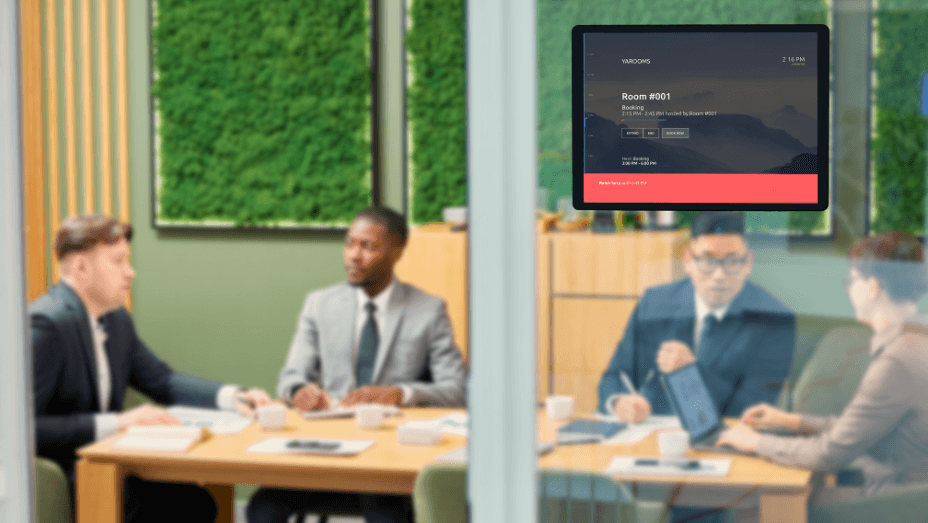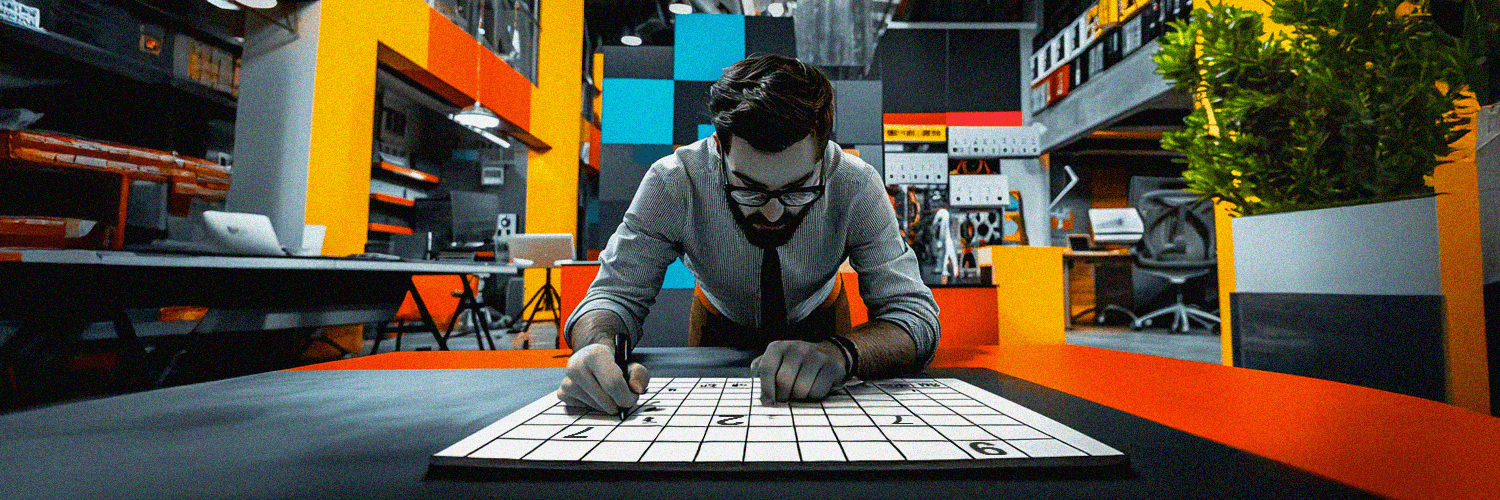Imagine this: you're entering a pivotal meeting, head buzzing with ideas, ready to impress. But the moment you walk in, you're met with complete disarray—papers scattered like confetti, a couple of forgotten coffee cups on the desk, and your coworkers frantically fiddling with the projector. Sound familiar?
These days, with meetings happening both in person and online, mastering the subtle art of meeting room etiquette has never been more crucial. It doesn't matter if you're a seasoned pro or just starting; knowing how to navigate the often-unspoken rules of meeting and conference rooms can either boost your reputation or sink it.
In this article, we'll share eight must-know meeting and conference room etiquette tips so you can leave a lasting impression for all the right reasons.
TL;DR:
- Meeting room etiquette involves following unwritten rules for professional behavior in shared spaces to ensure productivity and respect.
- Proper etiquette includes booking rooms in advance, arriving on time, keeping spaces clean, and minimizing disruptions.
- Good meeting etiquette enhances productivity, optimizes resource usage, and creates a positive workplace environment.
- Key principles include punctuality, adhering to dress codes, and maintaining digital decorum to reduce distractions.
- Hybrid meetings require balancing respect for both in-office and remote participants, fostering inclusive interactions.
- Effective communication and flexibility are essential to maintaining professional relationships and smooth meeting flow.
- Consistently following these rules contributes to a respectful, collaborative, and efficient work environment.
The Meaning of Meeting Room Etiquette
Meeting room etiquette refers to unwritten rules and behaviors governing how we conduct ourselves in shared meeting spaces. It's about more than just good manners; it reflects our professionalism, respect for colleagues, and commitment to productive collaboration. In essence, meeting room etiquette is the social lubricant that keeps the gears of workplace interaction running smoothly.
At its core, meeting and conference room etiquette encompasses a wide range of considerations. These include how we schedule and book conference rooms on time, ensuring everyone has access to a suitable time slot. It's also about remembering to close the door during meetings to minimize disruptions and maintain privacy. Meeting time should be respected, with participants arriving promptly to avoid delays. Additionally, maintaining an orderly office environment and making sure the conference rooms are clean after use show consideration for the next group.
Proper meeting room etiquette also involves effectively using technology, managing interruptions, and promoting inclusive interactions between in-person and remote participants in hybrid settings. Respecting these guidelines helps facilitate smooth transitions and keeps co-workers on track for a more productive work environment.
The Importance of Shared Meeting & Conference Rooms in the Workplace
Shared meeting and conference rooms play a crucial role in modern workplaces. These shared spaces serve as hubs for collaboration, creativity, and decision-making. They bring coworkers together, fostering face-to-face interactions that are often more productive and engaging than digital communication alone.
In an era where many companies adopt hybrid work models, these physical shared spaces become even more valuable. They provide a neutral ground for both in-office and remote employees to unite, bridging the gap between virtual and physical presence. Well-managed meeting rooms can enhance team cohesion, improve communication, and boost productivity.
Moreover, shared meeting spaces often serve as a company's face to external visitors, clients, and partners. Maintaining and using these spaces can leave a lasting impression on outsiders, potentially influencing business relationships and opportunities. This underscores the importance of maintaining proper etiquette in meeting and conference rooms.
By adhering to good meeting room etiquette, we not only show respect for our colleagues and the shared resources of our workplace but also contribute to a more efficient, harmonious, and productive work environment. In the following sections, we'll delve deeper into the principles and practices that make up effective meeting room etiquette, providing you with the tools to navigate these spaces confidently and professionally.

Benefits of Proper Meeting Room Etiquette for Productivity and Harmony
Sticking to good meeting room etiquette isn’t just about minding your manners—it actually plays a big role in keeping things productive and creating a more positive vibe in the workplace.
First and foremost, good conference room etiquette significantly improves meeting efficiency. Consider this startling statistic: 25-50% of meeting time is wasted on unproductive discussions and unnecessary tangents. By implementing proper etiquette, such as sticking to agendas and respecting time schedule limits, we can dramatically reduce this wasted time, making meetings more focused and productive.
Moreover, adhering to meeting room etiquette can lead to better decision-making and clearer outcomes. It's alarming that 46% of employees rarely or never leave meetings knowing what to do next. Proper rules for meeting schedule can foster an environment of respect and clear communication and ensure that everyone leaves meetings with a clear understanding of their tasks and responsibilities.
Another crucial benefit is resource optimization. By following etiquette rules around meeting room booking and cancellation, we can prevent double bookings and ensure more efficient use of these valuable resources, potentially reducing the need for additional meeting spaces and associated costs.
Proper etiquette rules for meeting rooms also play a vital role in maintaining workplace harmony. It shows respect for colleagues' time and efforts, which can significantly improve team dynamics and overall job satisfaction. This is particularly important because 67% of employees believe meetings waste time. By making meetings more efficient and respectful through good etiquette, we can help change this perception and boost employee morale.
Furthermore, adhering to the principles of conference room etiquette can enhance professional relationships with coworkers. When everyone follows the same rules, it creates a level playing field and reduces potential conflicts. This is especially crucial in hybrid work environments where maintaining cohesion between in-office and remote employees can be challenging.
Lastly, good meeting room etiquette contributes to a positive company culture. It sets a standard of professionalism that can permeate other aspects of work life, leading to a more respectful, efficient, and productive workplace overall. This can have far-reaching effects, from improved employee retention to a better company reputation.
8 Meeting & Conference Room Etiquette Tips
Understanding and implementing proper etiquette in meeting and conference rooms is crucial for fostering an orderly office environment. Let's explore eight essential principles that form the foundation of meeting etiquette.
1. Meeting Room Booking is Essential: Respect the Schedule
Respecting the schedule is fundamental to meeting room etiquette, as it ensures fair access to shared spaces and prevents disruptions like double bookings. Booking conference rooms in advance is key; it secures your spot and allows others to plan around your booking.
Most modern offices utilize meeting room booking systems (for example, Yarooms), so it's important to familiarize yourself with these tools and use them consistently. Always check the system or the advanced digital signage panel by the conference room door (they usually have color-coded availability and other meeting details on the screen) before assuming a room is free. And if your plans change, don’t forget to release your room reservation. Following these simple practices helps keep things organized and makes the office run much smoother.

2. Punctuality: The Key to Respecting Everyone's Time
Punctuality is an essential component of meeting room etiquette and a key to maintaining respect for everyone’s time. Arriving on time, or even a few minutes early, demonstrates professionalism and ensures meetings start as scheduled without causing delays or disruptions. It’s a small habit that leaves a big impression, showing respect for your coworkers and the shared time you have together.
If you’re running late, communicate with the meeting organizer as soon as possible to prevent unnecessary waiting. Likewise, for hosts, it’s crucial to start and end scheduled meetings on time, regardless of late arrivals. This sets a positive example and reinforces the value of punctuality. In hybrid work environments, punctuality becomes even more significant, keeping both in-office and remote participants aligned.
3. Scheduled Meeting Cancellations: The Courtesy of Early Notifications
Sometimes, despite our best efforts, meetings need to be canceled or rescheduled. When this happens, it's essential to notify all participants as soon as possible. Providing early notification is not just a matter of good meeting room etiquette—it's a sign of respect for your coworkers' time and schedules. By informing them promptly, you allow them to reclaim that time for other tasks or meetings.
Make sure to cancel the reservation in the meeting room booking system immediately. Doing so ensures that the conference room becomes available for others, preventing the "ghost meeting" problem—where rooms appear reserved but are empty. This small action can significantly help your coworkers, making the office a more organized and efficient for everyone. In essence, canceling a meeting early and updating the system is about being considerate and fostering a workplace culture that values clear communication and shared resources.
4. Keeping Rooms Clean: Leave No Trace Behind
A key aspect of meeting room etiquette is to keep the space clean and leave it as you found it—or even better. This simple habit respects shared workspaces and ensures everyone has access to a tidy and professional environment.
If food or drinks are allowed, be mindful of potential messes. Clean up spills immediately, dispose of trash, and remove leftover items. The next group using the room shouldn’t have to deal with your mess, so always make sure the space is ready. When it comes to equipment and furniture, handle everything with care. Return chairs to their original positions, erase whiteboards and ensure all technology is turned off or reset to its default state. If you’ve rearranged any furniture, be sure to put it back. Additionally, remember to keep the door closed when leaving to maintain privacy and minimize disruptions for others.
5. Accommodating Others: Flexibility and Thoughtfulness
Flexibility is a key component of meeting room etiquette. If another team urgently needs the space and your meeting can be moved, consider being accommodating and adjusting your schedule. Similarly, if your meeting ends earlier than expected, vacate the room promptly so it’s available for others to use without delay.
In hybrid meetings, this same mindset means being patient and understanding when colleagues encounter technical difficulties or background noise from their home environments. Showing empathy in these situations helps maintain a positive and supportive meeting atmosphere.
By embracing these principles of conference room etiquette, we foster a more efficient, respectful, and collaborative work environment. Good etiquette isn’t just about following rules—it’s about being considerate of your colleagues and actively contributing to a positive workplace culture.
6. Digital Decorum: Minimizing Distractions
In today’s tech-driven world, maintaining digital decorum is a vital part of meeting room etiquette. It’s about balancing connectivity with being fully present. One of the most common rules you’ll encounter is the request to silence or turn off mobile phones and other electronic devices.
While staying connected is important, constant notifications can be highly disruptive. Studies show that large conference rooms are often underutilized, so maximizing our time in these spaces is crucial to minimizing distractions. Electronic devices should be removed unless necessary for the meeting to promote better engagement and productivity.
Digital interruptions are sometimes unavoidable, but managing them effectively shows advanced conference room etiquette. Inform the meeting organizer beforehand if you expect an urgent phone call or message. If you need to respond, excuse yourself quietly and step outside.
7. Dress Code: Understanding the Expectations
Although office dress codes have become more casual, knowing what to wear for meetings is still crucial to meeting room etiquette. Your appearance influences how others perceive your professionalism, especially in meetings with clients or senior management. Taking care to dress appropriately shows respect for your colleagues and reinforces a positive image of yourself and your company.
If you're unsure what to wear, it's always safer to be slightly overdressed rather than underdressed. When in doubt, ask the meeting organizer or refer to your company's dress code policy. Making an effort to align with expected attire reflects well on you and contributes to a respectful and cohesive office environment for all employees.
8. Collaboration vs Interruption: Striking the Right Balance
Effective meetings thrive on collaboration, but there’s a fine line between engaging discussions and disruptive interruptions. Practicing good meeting etiquette means knowing when to contribute and when to listen. As an organizer, take care to invite only the employees who truly need to be there. With only 40% of seats typically occupied in meeting rooms, it’s clear that many meetings are larger than necessary, which can lead to more interruptions and less focused discussions.
When participating, be mindful of the flow of conversation. Wait for appropriate pauses before speaking, and respect the facilitator’s role in guiding the discussion. The aim is to collaborate and share ideas, not to compete for airtime.
It’s also essential to confirm availability and attendance in advance. Studies show that 15% of meetings in large conference rooms go unattended. By confirming participants and adjusting the meeting format if key attendees are unavailable, you can ensure that everyone’s time is used effectively and that the meeting remains productive for all employees.
Adhering to these advanced meeting room etiquette rules can help create more productive, respectful, and efficient meeting environments. Remember, good meeting etiquette isn't about rigid adherence to rules but about fostering mutual respect and collaboration. Whether managing digital distractions, dressing appropriately, or finding the right balance in discussions, these advanced etiquette guidelines can help elevate the quality of our meetings and, by extension, our work.

How a Meeting Room Booking System Can Help You With Conference Room Etiquette
A meeting room booking system can significantly improve conference room etiquette by streamlining the process of reserving and using meeting spaces. With such a system, employees can easily book conference rooms and view their availability, ensuring that everyone respects reservations and minimizes disruptions. Providing clear visibility on who has booked a room and when helps teams maintain a professional environment where meetings start and end on time.
Yarooms offers an advanced meeting room booking system to enhance space management and conference room etiquette. The solution includes a digital room booking platform where employees can quickly make reservations and check room availability. Additionally, Yarooms digital room door signage provides real-time information about ongoing meetings. With these features, Yarooms makes conference room reservation easy, promotes professional behavior, and maintains a seamless meeting experience for all.
Establishing and Communicating Meeting Room Etiquette Guidelines in the Office
Creating a culture of respect and efficiency in the workplace starts with clear communication of meeting room policies and etiquette guidelines. Let's explore how to effectively establish and share these rules and the benefits of doing so.
The Role of Management in Setting Expectations
Management plays a crucial role in establishing and enforcing meeting and conference room etiquette. Leaders should not only set clear expectations but also lead by example. This means adhering to the housekeeping rules and gently correcting breaches when they occur.
Managers should work with their employees to develop comprehensive meeting room policies that address common issues and align with the company's culture. These policies should cover everything from booking procedures to cleanliness standards and technology usage.
Management needs to explain the reasoning behind these rules. When employees understand that the policies are designed to improve productivity and create a more harmonious work environment, they're more likely to comply willingly.
Methods for Sharing Meeting Room Etiquette Policies
Once the meeting room etiquette policies are established, it's crucial to communicate them effectively. Here are some methods to consider:
- Employee Handbook: Include a section on meeting room etiquette in the company's employee handbook.
- Orientation Sessions: Introduce new hires to the meeting housekeeping rules during their onboarding process.
- Visual Reminders: Post meeting room etiquette signs in or near meeting spaces. These can serve as quick reminders of key rules.
- Digital Communication: Share the policies via company-wide emails or internal communication platforms.
- Regular Refreshers: Conduct periodic refresher sessions on meeting room etiquette, especially if new policies are introduced.
- Meeting Room Booking System Integration: Incorporate reminders of critical policies into the room booking system.
The Long-Term Benefits of Adhering to Meeting Room Etiquette
Consistently following meeting room etiquette can lead to numerous long-term benefits:
- Increased Productivity: More work gets done in less time when meetings run smoothly and efficiently.
- Improved Company Culture: A culture of respect in meeting spaces often extends to other work areas.
- Better Resource Management: Proper booking and use of meeting rooms lead to more efficient use of company resources.
- Enhanced Professional Image: Good meeting etiquette leaves a positive impression on clients and visitors.
- Reduced Conflicts: Clear policies and expectations minimize misunderstandings and conflicts related to meeting spaces.
- Improved Work-Life Balance: Efficient meetings mean less time wasted, potentially leading to better work-life balance for employees.
Companies can build a more efficient and cooperative workplace by setting clear rules for using meeting rooms, making sure everyone understands them, and applying them fairly. Keep in mind, proper meeting room behavior isn’t just about sticking to guidelines—it’s about creating a culture of respect and productivity that serves the whole team in the end.

Final Thoughts: Fostering a Culture of Respect and Collaboration
Meeting room etiquette is about fostering respect, efficiency, and collaboration to create a positive workplace culture. By following these guidelines—from booking and punctuality to balancing collaboration and interruptions—we can make meetings more productive and enhance team communication. As hybrid and remote work evolve, so must our approach to meetings, with flexibility and respect remaining key. Good etiquette reflects consideration for others' time, improves professional relationships, and positively impacts workplace culture. Ultimately, it's about being an effective team player and creating a productive environment for everyone, in-person or virtual.
Frequently Asked Questions About Meeting Room Etiquette
What Etiquette You Need to Follow in a Room for a Meeting?
When attending a meeting, adhering to basic room guidelines is crucial for maintaining a professional atmosphere. Always arrive on time or a few minutes early to prevent disrupting others. If the meeting is in a shared workspace or office environment, make sure to book the meeting room in advance to avoid any scheduling conflicts. Upon entering, close the door to maintain privacy and minimize external distractions.
During the meeting, silence your phone and avoid using it unless absolutely necessary. Engage actively by paying attention to the speaker, speaking clearly, and contributing thoughtfully without interrupting others. At the end of the session, ensure that the space is left in good condition. Keep it clean by disposing trash and returning furniture or equipment to its original position. This shows respect for the next group using the space and helps maintain a positive and organized environment. Following these simple etiquette rules can significantly enhance the meeting experience for everyone involved.
What Are the Rules for Boardroom Meetings?
Boardroom meetings often have a more formal atmosphere and require stricter adherence to etiquette. Employees should come prepared with any necessary materials or presentations. Dress appropriately for the occasion, usually in business attire. Address others respectfully, using titles if applicable. Wait to be recognized by the chair before speaking. Avoid side conversations and stay focused on the agenda. Be mindful of time constraints and keep your contributions concise and relevant. After the meeting, follow up on any assigned tasks promptly.
What Should You Do Before Leaving the Meeting Room?
Before exiting a meeting room, follow proper room guidelines to ensure a smooth transition for the next set of employees using the space. Start by ensuring you've collected all your personal belongings and cleaned up any materials you used, such as erasing whiteboards or disposing of paper. If the room was reserved through a booking system, make sure your scheduled time has concluded before leaving.
If you've used any equipment, turn it off and return it to its proper place. Arrange chairs and tables back to their original positions, and if you've adjusted the room temperature or lighting, restore these to their standard settings. When leaving, ensure the closed door policy is followed to maintain security and confidentiality, especially if sensitive discussions take place. Finally, double-check that you haven't left any confidential materials behind. These actions demonstrate respect for the workspace and consideration for the next group using the room.
Do's and Don’ts for Meetings?
Do:
- Arrive on time and prepared
- Participate actively and constructively
- Listen attentively to others
- Stick to the agenda and respect time limits
- Follow up on action items after the meeting
Don't:
- Interrupt others while they're speaking
- Engage in side conversations or use your phone unnecessarily
- Dominate the discussion or go off-topic
- Leave the room in disarray
- Forget to mute yourself in virtual meetings when not speaking
By following these do's and don'ts, employees can contribute to more productive and respectful meetings. Remember, good meeting etiquette creates an environment where everyone can contribute effectively and feel valued. These room guidelines not only improve the efficiency of meetings but also foster a positive workplace culture. Whether you're in a boardroom or a casual team huddle, these principles of meeting room etiquette will serve you well in your professional interactions.












